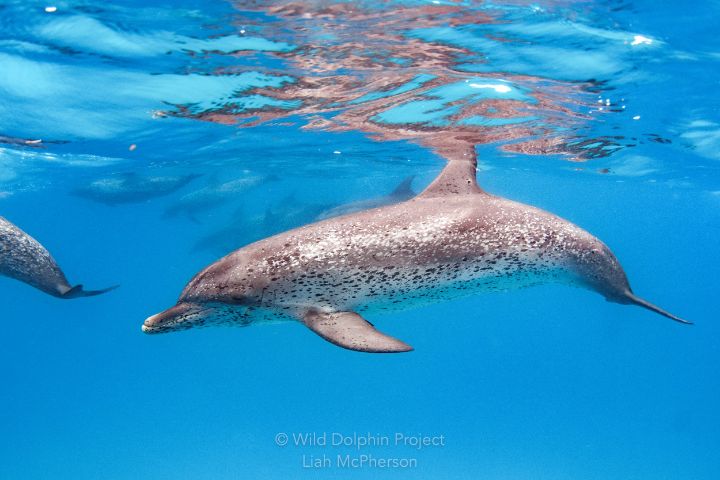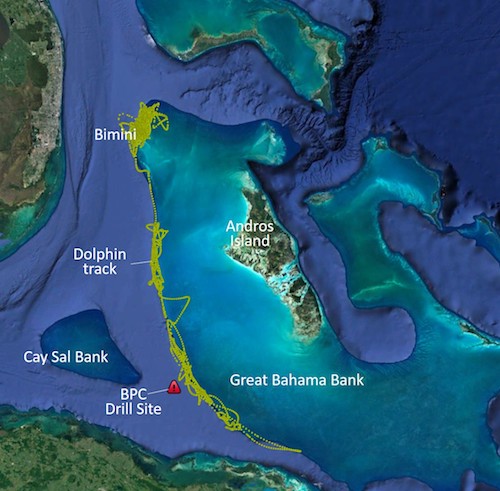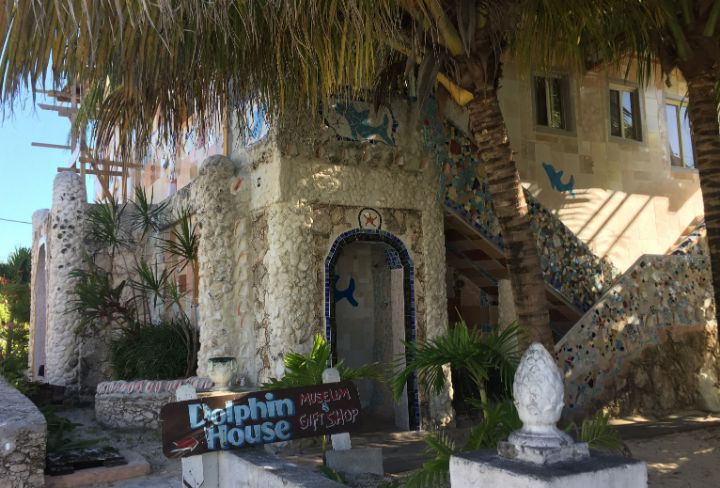|

|
 |
|
Last Updated: Nov 13, 2020 - 1:52:24 PM |

Lamda, an adult male spotted dolphin and other spotted dolphins attract 1,000s of tourists every year to watch them in the beautiful waters off Bimini (photo courtesy of the Wild Dolphin Project).
|
New study shows Bimini dolphins use waters around BPC exploratory drill site highlighting inadequate EIA and potential threat to Bimini’s million-dollar dolphin-watching industry
Bahamas Petroleum Company’s Environmental Impact Assessment states, “In completing the impact assessment, relevant uncertainties and gaps identified are primarily related to lack of primary baseline data for wildlife”. These “uncertainties” and “gaps” mean that BPC cannot predict what impacts their drilling for oil will have on Bahamian marine life, including dolphins and whales, without baseline data collected prior to any drilling activity.
A study published yesterday in the scientific journal, Aquatic Mammals, highlights just how little is known about the significance of the proposed exploratory drill location to dolphins that are part of a $1 million business in Bimini. Dr Charlotte Dunn, a Senior Scientist at the Abaco-based Bahamas Marine Mammal Research Organisation (BMMRO), is lead author. Dr Dunn says “The key message from our study is that BPC’s exploratory drill area may be of significant importance to Bimini’s dolphins. Until now, no-one knew that Bimini dolphins used waters that far south, highlighting how little is known about wildlife in this remote location and the need for BPC to carry out dedicated marine mammal surveys prior to any drilling to fill these critical gaps in their EIA.”

Satellite-linked track of Lamda’s movements (in yellow) from his 29 October 2018 release until his tag stopped transmitting on 14 February 2019 and the site of Bahamas Petroleum Company’s proposed exploratory oil well (in red).
|
Dr Diane Claridge, BMMRO’s Executive Director, questions why the Bahamian government did not require BPC to fill these gaps before granting the license to drill. “The risk of oil drilling to air breathing animals like dolphins is huge. Bottlenose dolphins in the Gulf of Mexico are still dying from respiratory disease and reproductive failure 10 years after the Deep Water Horizon spill, which occurred at an exploratory well. Some oceanic dolphin populations in the Gulf won’t recover for over 100 years. Marine mammals are protected species by law in The Bahamas; we cannot ignore the impacts of oil drilling simply because we lack data.”
Dr Claridge adds: “BPC’s EIA is incomplete without baseline data on marine mammals. We know that many species are found in the drill area, but not how large or small these populations are, what threats they currently face, or whether the area includes important habitat for these species. This information is critical to assessing impacts from drilling a test well and future oil exploitation.”
The study reports on an adult Atlantic spotted dolphin (nicknamed “Lamda”) that stranded in the Berry Islands, was rehabilitated at Atlantis and a month later released off Bimini. Before release, it was instrumented with a satellite tag so researchers could monitor its movements.
Prior to stranding, “Lamda” was a well-known individual in a community of dolphins from Bimini. Recognized by his unique, natural spotting, he has been observed off Bimini by researchers and dolphin-watching boats since 2010, when he was just a young dolphin. These Bimini-based operators watched Lamda grow up and saw him just two weeks before he stranded.

Ashley Saunders began building this amazing house in 1993 as a tribute to Bimini’s dolphins. Today it is Bimini’s most popular tourist attraction.
|
Spotted and bottlenose dolphins commonly occur close to Bimini, leading to a thriving dolphin-watching industry. Tourists and filmmakers flock to Bimini to experience the dolphins in our clear turquoise waters, contributing an estimated $1 million to the local economy. Ashley Saunders’ famous “Dolphin House Museum” is a must-see for all visitors to Bimini.
Dominic Cox, PR Manager for the Museum provided this statement: “With deep love and reverence for the ocean and all the diverse life it sustains, we at the Dolphin House Museum stand against any drilling for oil amid marine ecosystems that are precious and vital to the Bahamian people and our American neighbors to the west. The Bahamas international tourist economy is completely supported by and dependent on the seas that surround the Bahamian islands. We cannot afford, with the economic devastation this pandemic has created thus far, to add any further damage to an already fragile Bahamian economy. We respect the government's efforts to generate a new source of revenue during these very challenging times, but the marine environment is an asset to the Bahamas that you simply cannot put a price on.”
After Lamda’s release, the dolphin travelled about 200 miles south of Bimini along the western edge of Great Bahama Bank until he was south of Quinchos Cay. Lamda spent 13 days in BPC’s proposed exploratory drill area and then another 16 days travelling back north, stopping near Orange Cay before continuing back to Bimini (see map of Lamda’s track). He remained in the Bimini area until his tag stopped transmitting on 14 February 2019. Since then, researchers and dolphin-watchers have seen Lamda near Bimini 23 times.
Al Sweeting, owner and operator of Bimini Adventures says: “People from all over the world travel to Bimini to see and interact with wild dolphins. Everything possible should be done to protect these dolphins and keep their environment pristine. The possible impacts of drilling for oil nearby are truly frightening. But it’s not just the dolphins that would be affected by an oil spill, it’s all our marine life, that’s our groupers, snappers, jacks, tuna, sharks, turtles, you name it; not to mention our coral reefs and beaches. Is it wise to risk a total economic loss to Bimini?”
BMMRO scientists share this concern for Bimini’s economy. The spill models presented in BPC’s EIA predict that an oil slick could come ashore in Bimini, west Andros, Cay Sal and even in Sandy Point, Abaco (where BMMRO is based), hundreds of miles away.
Dr Claridge adds: “BPC has been given the go-ahead despite an EIA that is lacking critical information about the marine wildlife which forms the basis of the Bahamian economy. With a planned drill date for December 15th, 2020, BPC appears to be taking advantage of our country as we are struggling with the worst crisis in our history and are ill-prepared to respond.”
Dr Dunn continues: “The Government’s Economic Recovery Committee did not include oil drilling in their recovery plan but instead recommended growth in renewable energies. We installed solar at BMMRO 2 years ago and have benefitted from uninterrupted service throughout the months of power outages in Abaco following hurricane Dorian. The Bahamas needs to invest in renewables and not become a contributor to the climate change crisis resulting from fossil fuel production and use.”
For these reasons (and many more), the Bahamas Marine Mammal Research Organisation has joined the growing coalition led by Our Islands, Our Future telling the Bahamian government to stop the proposed test drilling in December.
Co-authors in the study included scientists from the Wild Dolphin Project and the Dolphin Communication Project who have been conducting dolphin studies in The Bahamas since 1985, Chicago’s Zoological Society’s Sarasota Dolphin Research Program (who provided the satellite tag) and “Lamda”’s rehabilitation team at Atlantis’ Dolphin Cay.
The Bahamas Marine Mammal Research Organisation (BMMRO) is a non-profit group based in Sandy Point, Abaco whose mission is to promote the conservation of marine mammals through scientific research and educational outreach. To learn more about BMMRO’s work, see the following links: www.bahamaswhales.org, www.facebook.com/bmmro, www.twitter.com/bmmro, www.instagram.com/bmmro.
Link to the published paper:
https://www.aquaticmammalsjournal.org/index.php?option=com_content&view=article&id=2096:satellite-linked-telemetry-study-of-a-rehabilitated-and-released-atlantic-spotted-dolphin-in-the-bahamas-provides-insights-into-broader-ranging-patterns-and-conservation-needs&catid=190&Itemid=326
Link to YouTube video documenting the Lamda rescue and release:
https://www.youtube.com/watch?v=ULjNBdABUk8

© Copyright 2020 by thebahamasweekly.com
Top of Page
|
|
 |

|
